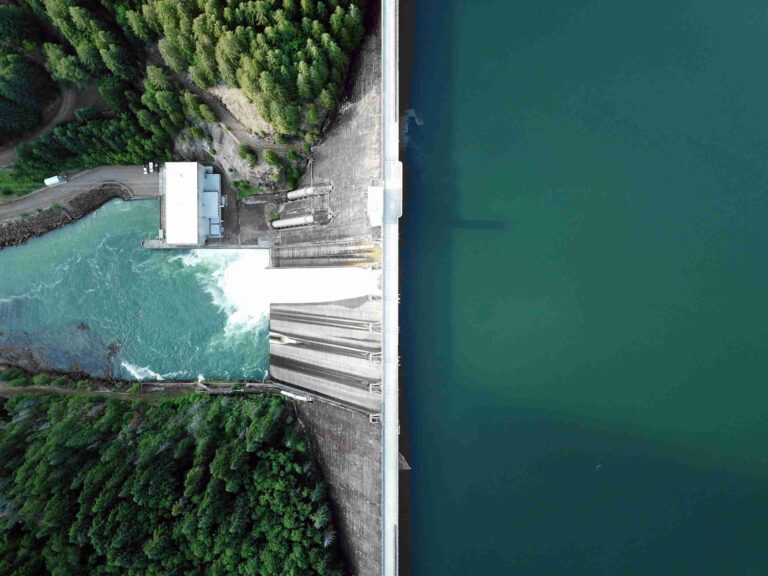Hydroelectric power, commonly referred to as water power or hydroelectricity, is the process of using falling or swiftly flowing water to generate electricity or drive machinery.
This power, which is frequently found in rivers and streams that originate in hills and mountains, is a sustainable energy generation technique because it uses the kinetic energy or gravitational potential of a water source to generate power.
Innovation in this industry has never slowed down over the course of its nearly 15-year lifespan. At the moment, the main emphasis is on improving the flexibility of plants through improvements in the design and operation of the turbines as well as through digitalization.
Table of Contents
The 5 leading countries in hydroelectric power
The following are the 5 leading countries in hydroelectric power production:
1. China
With a contribution of approximately 21 GW to the additional capacity that went online in 2021, China continued to set the pace for new development. The additional capacity additions included 4.7 GW of pumped storage hydropower, an increase from the 1.5 GW added in 2020.
Once more, the majority of this (4.5 GW) was produced in China, including 600 MW of capacity at the Fengning Pumped Storage Facility, which will be the largest in the world when it is finished in 2023 and has a 3,600 MW capacity.
2. Brazil
With almost 55% of the nation’s output coming from hydropower in 2021, it is clear that this is the primary method used in Brazil to generate electricity. Brazil’s production came from 11 and 7.9% of other renewable sources, respectively, including wind and biomass. Brazil produced approximately 656 terawatt-hours of power that year.
The terrain of Brazil is ideal for the generation of hydropower. Brazil is ideally suited for the development of hydroelectricity due to its varied topography, substantial rivers, and significant levels of precipitation.
Construction of dams and the use of gravity to regulate water flow are possible by the huge rivers and elevation differences. The heavy precipitation ensures a steady flow of water, which enables a steady supply of energy to be produced. Brazilian hydropower accounts for more than 80% of its electrical output.
3. Norway
With a combined capacity of more than 87 TWh, Norway has more than 1000 hydropower storage facilities. There is nearly half the storage capacity in the 30 major reservoirs. 70% of the yearly Norwegian electricity usage is corresponding to total reservoir capacity. Before 1990, the majority of the reservoirs were built. The reservoirs are now used more effectively thanks to hydropower plant upgrades and expansions.
The Norwegian electricity grid still relies heavily on hydropower. There were 1681 hydropower plants in Norway at the beginning of 2021, with a total installed capacity of 33 055 MW. The Norwegian hydropower facilities generate 136.4 TWh annually, about 90% of Norway’s total electricity output. A additional 2.3 TWh was being built at the start of 2021.
4. Canada
For more than 130 years, water has powered Canada from coast to coast, supplying abundant, clean, affordable, renewable energy for homes, businesses, technology, electric vehicles, and other uses. Currently, more than 550 hydropower facilities exist in Canada, providing more than 60% of the country’s electricity demands. Canada’s Green Battery, the fourth-largest waterpower producer, installed 82,307 Megawatts capacity.
One of the most pressing and difficult issues facing Canada’s future economic resilience is the energy transition. Its success depends on a significant growth of electricity. Hydropower producers are ready to address one of the most pressing concerns of our day as the nation struggles to achieve net zero carbon emissions by 2035. They have the knowledge, the projects, and the technology necessary. The move to sustainable energy in Canada is possible and fueled in large part thanks to hydropower.
5. USA
The percentage of energy produced in the United States by hydroelectricity has dropped through time, primarily as a result of increases in the production of power from other sources.
In 2021, hydropower generated 31.5% of the nation’s total renewable electricity and around 6.3% of the nation’s overall electricity.
In fact, all states use hydropower in some capacity or another to generate electricity, with the exception of Delaware and Mississippi. For instance, hydropower supplied about 66% of Washington State’s electricity in 2020.
When demand changes, hydroelectric power may nearly quickly raise or reduce
The contribution of hydropower exceeds that of all other renewable energy sources combined, including wind, solar photovoltaic, biofuel, and geothermal, by a factor of 55 percent and is higher than that of nuclear power.
The third-largest source of energy generation in 2020 behind coal and natural gas was hydropower, which provided 17% of the world’s electricity. Approximately half of the world’s economically feasible hydropower potential is unrealized. Since it almost reaches 60%, this potential is especially great in rising and developing economies.
Because it doesn’t require much period like many combustion technologies do, hydropower is significant from an operational perspective. When demand changes, hydropower may nearly quickly raise or reduce the quantity of power it is sending to the system.
With its crucial load-following capabilities, peaking capacity, and voltage stability characteristics, hydropower contributes significantly to guaranteeing dependable electrical delivery and to satisfying consumer expectations in the sector. The only substantial method of electricity storage that is currently accessible is through hydroelectric storage facilities.
Read also: Photovoltaics, the 2022 leading countries for solar energy production












